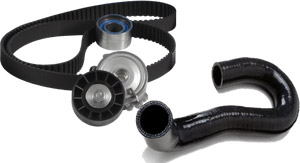
Because we care about our customers, here are some great tips for winter safety:
Stock your car with emergency supplies. You never know when you’ll get stranded on the side of the road. Be prepared by having your car packed with emergency supplies.

Check your battery. The chemical reactions required to generate power in a car battery slow down in extremely cold temperatures. At 5 degrees F, a fully charged lead-acid battery has only half its rated amp-hour capacity. On top of that, during cold weather, your engine requires more current from the battery in order to get the engine started. At Hillside Auto Repair, our mechanics can run a battery load test to see if you need to replace the battery. Even if you don’t, we can check for and clean up any corrosion he finds on your posts and connections.

Check your anti-freeze mixture. The mixture of anti-freeze and water in your radiator should be about 50:50.

Check your belts and hoses. Check them for any signs of wear and tear and have them replaced if needed. Cold temps can weaken the belts and hoses that help make your engine run.

Change your wiper blades and refill your wiper fluid. You need to see the road to drive safely, but the build-up of winter precipitation and salt on your windshield can greatly reduce visibility. Most wiper blades are only good for a year. Replace yours if they look frayed or worn. Top off your wiper fluid reservoir with a brand that has a lower freezing temperature.
Check your tire pressure. Cold weather causes air pressure in your tires to drop. For every 10 degrees drop in temperature, your tire’s air pressure will drop about 1psi. A properly inflated tire ensures the best possible contact between the road and the tires which is essential for safe traction when driving in wintry conditions.
Check your four-wheel drive. Have your 4WD checked by a mechanic before winter weather sets in. They’ll ensure the system engages smoothly and that the transmission and gear fluids are at their correct level.
Change the oil and adjust the viscosity. The colder it is outside, the thicker the oil gets, and thick oil doesn’t circulate through your engine as easily as thin oil. Consequently, your engine doesn’t get the lubrication it needs during start-up and then the car might not start.
It’s best to change your oil to one that is thinner to begin with. To find out the proper viscosity (that’s the thickness or thinness of a liquid) of oil you need in the winter, check the owner’s manual for your car. They usually have information on proper viscosity levels for different climates. You can also just request on of our friendly technicians to do this for you!
If you become stranded or see another vehicle stranded on the side of the road with passengers, please call the Missouri State Highway Patrol emergency number. These numbers ring at the nearest troop headquarters.